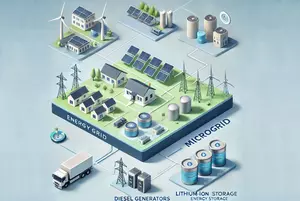A close examination of global voltage standards reveals a general range of 100–240VAC at either 50 or 60Hz. This might suggest that a single power supply supporting the entire voltage and frequency spectrum would be universally compatible – but that’s not necessarily the case. See the example safety label for a certified, globally shipping power supply in figure 2.
It may seem natural to want to support as wide a range as possible, but as with anything in life (especially power), there are tradeoffs to consider when optimizing a solution for a specific application or use case. Designs must also include tolerances to account for non-ideal operating conditions. In terms of voltage, this includes protections for overvoltage scenarios (typically for both personal safety and equipment protection), undervoltage conditions (to maximize uptime and protect equipment), and balancing phase currents in multiphase systems. For line frequency, considerations relate to power quality and grid stability.
The specific mechanisms and methods for achieving these protections are beyond the scope of this discussion but are covered in detail in the RECOM
AC/DC Book of Knowledge: Practical Tips for the User [3], which is freely available. By applying a common tolerance figure of ±10%, we can define a broad operational range of 90–264VAC and 47–63Hz – commonly seen on power supply safety labels. This example demonstrates how diverse international standards can be consolidated into more universally supported ranges, though it does not explore the motivations behind individual regional mains specifications. Additional support ranges also exist for military and industrial environments, such as the 400Hz standard used in aircraft and shipboard power systems. In three-phase AC configurations, multiple single-voltage sources may be separated by phase angle to maximize power delivery while minimizing current loads.
Ultimately, most end systems and loads will run off of DC power (AC motors being the glaring exception), which is why there are even more standards for DC voltage supplies than AC, though not typically for facilities or building-scale distributions. High voltage is defined as >1,000/1,500V (AC/DC, respectively), though pretty much anything ≥60VDC is considered high voltage for safety purposes (human contact), also known as Safety Extra Low Voltage (SELV).
While no single standard exists (actually, numerous exist worldwide) for what is commonly referred to as the high-voltage data center (HVDC – not to be confused with high-voltage direct current), many standards define distribution architectures in the 300–400VDC range. The logic is: if server/networking hardware and supporting infrastructure are all designed to support a universal AC input with a
power-factor-correcting (PFC [4])
AC/DC power supply, then the same equipment can accept the DC voltage derived from the rectified AC waveform – justifying the elimination of a conversion stage (and all the benefits gained by its removal).
24VDC distributions are common in industrial settings with small relays, breakers, motors, and systems optimized for a standard mechanical form factor, such as the
DIN rail [5] standard. Other well-known DC distributions include the Universal Serial Bus (USB, 5–20VDC) and Power over Ethernet (PoE, 44–57VDC), which also combine power with data conductors in hybrid cables. The choice of a main distribution voltage for a facility is driven by many factors tied to decisions around capital and operational expenditures (CAPEX/OPEX, respectively) – not simply what equipment needs to plug into it. Safety is almost always a key factor in determining distribution architectures and must be considered based on worst-case scenarios for operator exposure, conductor-to-conductor spacing, and constraints within the operating environment.
Consolidating voltage distribution bus architectures offers several advantages, including streamlined equipment procurement (CAPEX) and more efficient use of equipment and machines (OPEX). The fewer the conversion stages from upstream sources (e.g., utility grid, energy storage, etc.) to the end load (e.g., system, ASIC, motor, etc.), the greater the potential to simplify infrastructure and leverage economies of scale. Commonality can also help mitigate net load dynamics, enabling improved energy efficiency by reducing unpredictability and opening up more opportunities for intelligent power management (IPM [6]) techniques.
A common mains or distribution architecture carries far more benefits than can be comprehensively reviewed here, but a few additional categories are worth recognizing. The ability to maintain a more predictable maintenance schedule and manage fewer part numbers can result in significant savings – both in the short and long term. A reduced number of parts to replace or manage offers several clear advantages, from saving user effort at the point of consumption to lowering overhead and shipping costs for replacements.
As we transition to Smart Buildings and factories of the future, achieving both configurability and agility through common form factors is critical for success. From a quality perspective, systems – particularly components and motors – will have longer lifespans when operating in more constrained, predictable environmental conditions and maintenance cycles. These first-order benefits cascade into a wide range of second-order advantages, depending on how deeply one chooses to analyze the system. For example, a common distribution architecture can reduce the need for costly backup power or energy storage solutions that would otherwise serve as buffers for intermediary voltages. Even a small improvement in the efficiency of input-to-output power commutation – just a few percentage points – can justify substantial CAPEX savings, with benefits extending all the way from the
point of load up to the power plant.





